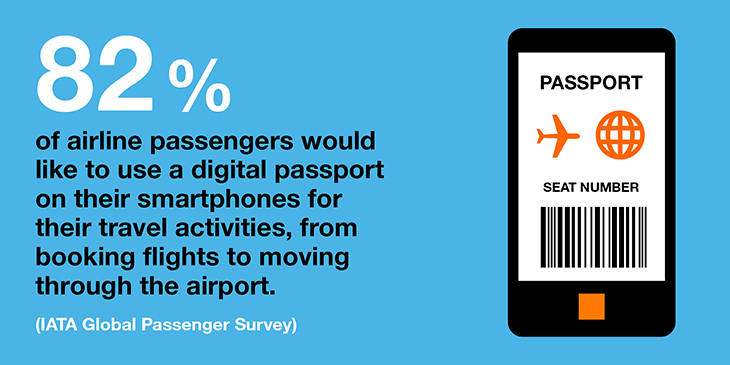82% of airline passengers would like to use a digital passport on their smartphones.
Growth in air travel passenger numbers continues inexorably, putting all infrastructure under pressure. Nowhere is this more noticeable than at the airport, where increased security, passenger numbers and disruption can all combine to create a stressful travel experience.
Imagine passing through an airport quickly and easily, using just your smartphone and biometrics all the way from check-in to boarding to arrivals, and always being able to verify your identity using processes that are similar in all countries and airports. This vision is being powered by advances in biometrics and security technology, along with widespread smartphone adoption.
We’re already seeing some early examples of how the concept would work. For example, air transport industry (ATI) technology provider SITA has built a system with airline JetBlue, Boston’s Logan International Airport and U.S. Customs and Border Protection (CBP) that allows passengers to board flights by simply presenting their faces to a camera. It has been dubbed “board by selfie” and has been very popular with passengers, with accurate matching almost at 100%.
Most JetBlue passengers at Boston now choose to use this system rather than a conventional boarding card. “This acceptance is in line with our experience and the results of a 2017 SITA Passenger IT Trends Survey, which shows that not only do passengers prefer to use technology, but when they do, it boosts satisfaction rates,” said Randy Pizzi, SITA President, Americas.
Changi Airport in Singapore is looking at extending the concept even further. It is investigating using facial recognition technology to help locate lost travelers or those late for flights to improve the flow of passengers through the airport and to cut delays. It already uses facial recognition in self-service bag drop and immigration.
Laying the foundations
In fact, countries as diverse as Oman, the U.S. and Australia already use biometrics widely in automated border entry systems. Facial recognition is popular because ePassports already store a digitized version of the bearer’s photo. Fingerprints are an alternative – and their adoption is supported by fingerprint reading technology integrated into smartphones.
Nearly all passengers already carry smartphones when they travel. In fact, SITA’s 2017 Passenger IT Trends Survey found that 98 percent carried at least one device, with 70 percent carrying two. And consumers are perfectly accepting of using biometrics in their everyday activities. A recent study by Visa found that 86 percent of U.S. consumers were interested in using some form of biometric identity to verify payments.
It’s the same with travel: the IATA Global Passenger Survey found that 82 percent of passengers would like to use a digital passport on their smartphones for their travel activities, from booking flights to moving through the airport. Two-thirds wanted to use biometric identifiers as their travel token.
"Passengers want to use one single biometric identity token for all their travel transactions, from booking flights to passing security and border control and picking up their bags,” said Nick Careen, IATA's Senior Vice President for Airport, Passenger, Cargo and Security.

Stakeholders working together
Clearly, successful implementation of biometric travel tokens requires multiple stakeholders to work together, especially governments, airlines and airports. In practice the traveler would enroll their biometric identity via a government scheme, and then have this associated with their right-to-fly issued by the airlines. This would create a biometric token for travel, which could be stored on the smartphone.
The airport and its stakeholder could then verify the person’s identity against the enrolled biometric travel token at each stage of the traveler's journey throughout the airport – from check-in to boarding gates. This could all be done with automated gates using cameras, meaning that the passenger wouldn’t have to physically interact with any touchpoint, apart from at the baggage drop.
Of course, to make this work effectively, there needs to be a trust framework in addition to the enrollment and verification process. How do you securely share data between the stakeholders, while ensuring its accuracy and fidelity? And further, how do you share this information beyond national borders? Ultimately, it could allow passengers to be pre-cleared and their identity sent with them to their destination.
Perhaps most importantly, any developed system would have to comply with a range of different legislation and regulations that governs personal data.
Building consensus with IATA
As an air transport industry body, IATA can play a key role in helping deliver this vision. In 2018, IATA published the OneID concept paper that addresses the issue. The report calls on stakeholders to agree on a common approach to delivering integrated identity management across the end-to-end passenger process. This process needs to incorporate booking, pre-departure, departure, transfer, arrivals and the return trip for both international and domestic travel. “The basic principle is that passenger data is collected, admissibility is assessed, and identity is confirmed as early as possible in the process, and is subsequently shared, used and amended by all stakeholders across the end-to-end journey,” states IATA.
IATA wants to enable a common approach to designing and deploying systems so that they will support worldwide travel, much like what has been achieved with the ICAO international ePassport standard. To do this, it will need to build consensus in four areas, namely implementation, technology standards, legal and regulatory requirements, and business case.
Although we are still some way off full international travel on your enrolled biometric, there is a strong appetite from all stakeholders and passengers to make this a success. And as such, we will continue to see more localized projects that will help test the technology and processes required. Ultimately, biometrics promises to help create a more comfortable flying experience for all of us.
Discover our strategic partnership with SITA and how we work together to develop innovative solutions for the air transport industry.